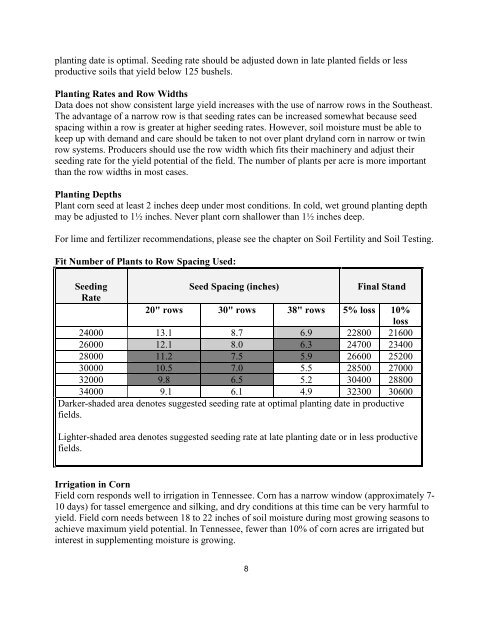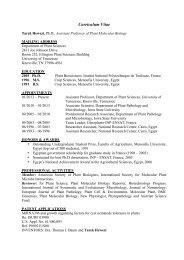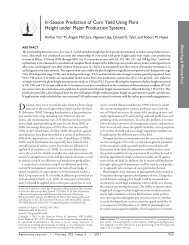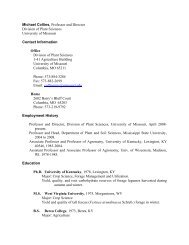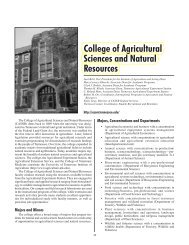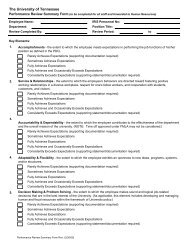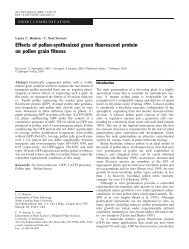CATEGORIES OF FORAGE CROPS - Department of Plant Sciences
CATEGORIES OF FORAGE CROPS - Department of Plant Sciences
CATEGORIES OF FORAGE CROPS - Department of Plant Sciences
Create successful ePaper yourself
Turn your PDF publications into a flip-book with our unique Google optimized e-Paper software.
planting date is optimal. Seeding rate should be adjusted down in late planted fields or less<br />
productive soils that yield below 125 bushels.<br />
<strong>Plant</strong>ing Rates and Row Widths<br />
Data does not show consistent large yield increases with the use <strong>of</strong> narrow rows in the Southeast.<br />
The advantage <strong>of</strong> a narrow row is that seeding rates can be increased somewhat because seed<br />
spacing within a row is greater at higher seeding rates. However, soil moisture must be able to<br />
keep up with demand and care should be taken to not over plant dryland corn in narrow or twin<br />
row systems. Producers should use the row width which fits their machinery and adjust their<br />
seeding rate for the yield potential <strong>of</strong> the field. The number <strong>of</strong> plants per acre is more important<br />
than the row widths in most cases.<br />
<strong>Plant</strong>ing Depths<br />
<strong>Plant</strong> corn seed at least 2 inches deep under most conditions. In cold, wet ground planting depth<br />
may be adjusted to 1½ inches. Never plant corn shallower than 1½ inches deep.<br />
For lime and fertilizer recommendations, please see the chapter on Soil Fertility and Soil Testing.<br />
Fit Number <strong>of</strong> <strong>Plant</strong>s to Row Spacing Used:<br />
Seeding<br />
Seed Spacing (inches)<br />
Final Stand<br />
Rate<br />
20" rows 30" rows 38" rows 5% loss 10%<br />
loss<br />
24000 13.1 8.7 6.9 22800 21600<br />
26000 12.1 8.0 6.3 24700 23400<br />
28000 11.2 7.5 5.9 26600 25200<br />
30000 10.5 7.0 5.5 28500 27000<br />
32000 9.8 6.5 5.2 30400 28800<br />
34000 9.1 6.1 4.9 32300 30600<br />
Darker-shaded area denotes suggested seeding rate at optimal planting date in productive<br />
fields.<br />
Lighter-shaded area denotes suggested seeding rate at late planting date or in less productive<br />
fields.<br />
Irrigation in Corn<br />
Field corn responds well to irrigation in Tennessee. Corn has a narrow window (approximately 7-<br />
10 days) for tassel emergence and silking, and dry conditions at this time can be very harmful to<br />
yield. Field corn needs between 18 to 22 inches <strong>of</strong> soil moisture during most growing seasons to<br />
achieve maximum yield potential. In Tennessee, fewer than 10% <strong>of</strong> corn acres are irrigated but<br />
interest in supplementing moisture is growing.<br />
8


